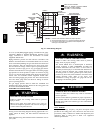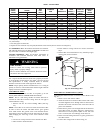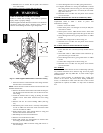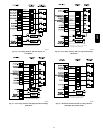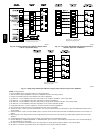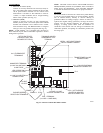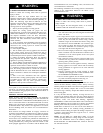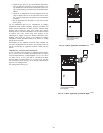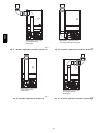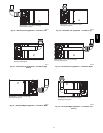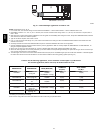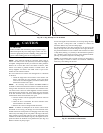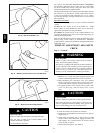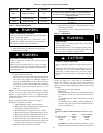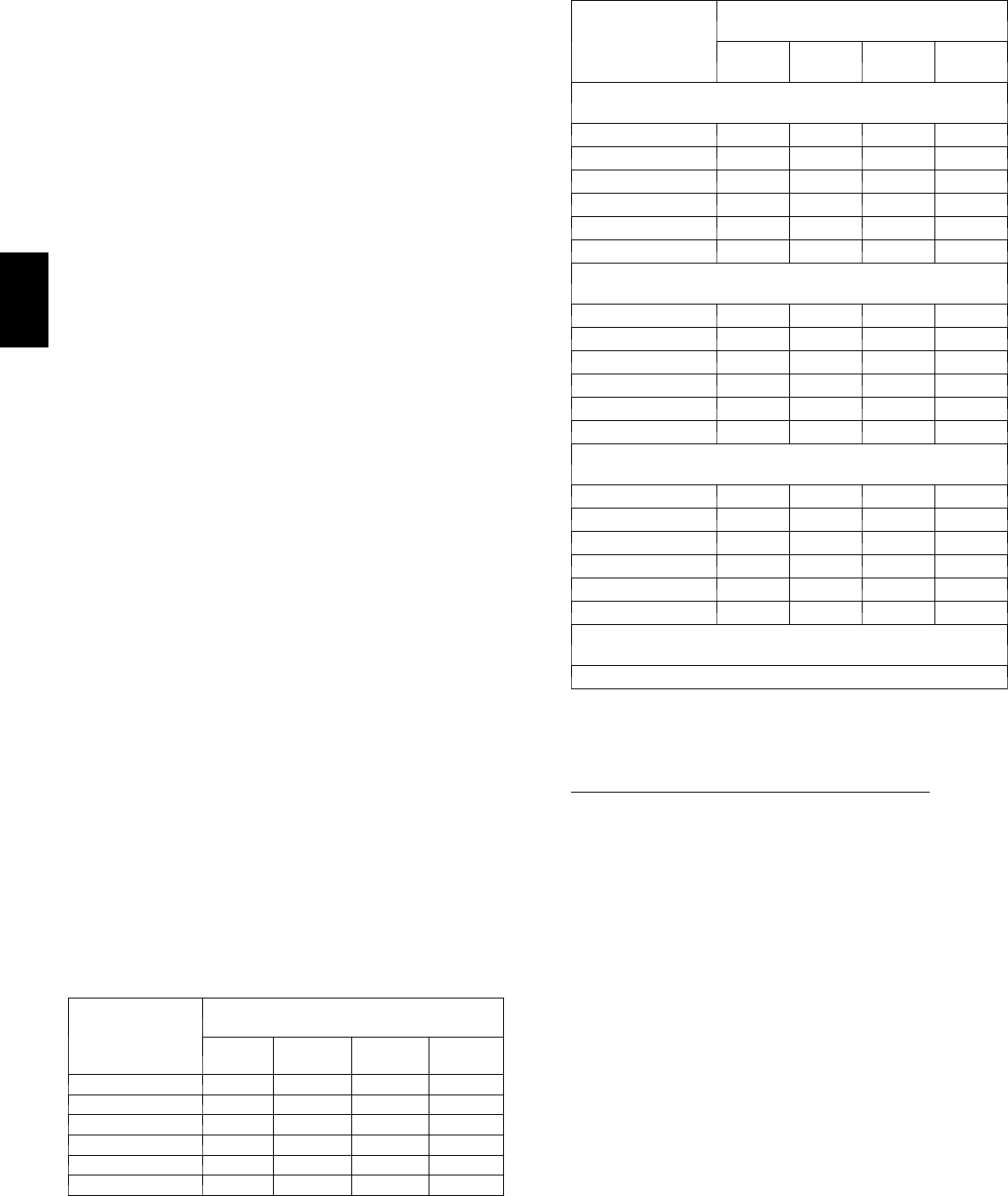
28
The Chimney Adapter Kit is a listed alternative venting system
for these furnaces. See the kit instructions for complete details.
Canada (and U.S.A.)--This furnace is permitted to be vented into
a clay tile--lined masonry chimney that is exposed to the outdoors
below the roof line, provided:
1. Vent connector is Type--B double--wall, and
2. This furnace is common vented with at least 1 draft hood--
equipped appliance, and
3. The combined appliance input rating is less than the max-
imum capacity given in Table 8, and
4. The input rating of each space heating appliance is greater
than the minimum input rating given in Table 9 for the
local 99% Winter Design Temperature. Chimneys having
internal areas greater than 38 in
2
(24516 mm
2)
require fur-
nace input ratings greater than the input ratings of these
furnaces. See footnote at bottom of Table 9, and
5. The authority having jurisdiction approves.
If all of these conditions cannot be met, an alternative venting
design shall be used, such as the listed chimney adapter kit with a
furnace listed for use with the kit, a listed chimney--lining system,
or a Type--B common vent.
Inspections before the sale and at the time of installation will
determine the acceptability of the chimney or the need for repair
and/or (re)lining. Refer to Fig. 34 to perform a chimney
inspection. If the inspection of a previously used tile--lined
chimney:
a. Shows signs of vent gas condensation, the chimney
should be relined in accordance with local codes and the
authority having jurisdiction. The chimney should be re-
lined with a listed metal liner, Type--B vent, or a listed
chimney adapterkitshallbe usedtoreducecondensation.
If a condensate drain is required by local code, refer to
theNFPA 54 /ANSIZ223.1--2006, Section12.10 forad-
ditional information on condensate drains.
b. Indicates the chimney exceeds the maximum permissible
sizein thetables,thechimneyshould berebuiltor relined
to conform to the requirements of the equipment being
installed and the authority having jurisdiction.
A chimney without a clay tile liner, which is otherwise in good
condition, shall be rebuilt to conform to ANSI/NFPA 211 or be
lined with a UL listed (ULC listed in Canada) metal liner or UL
listed Type--B vent. Relining with a listed metal liner or Type--B
vent is considered to be a vent--in--a--chase.
If a metal liner or Type--B vent is used to line a chimney, no other
appliance shall be vented into the annular space between the
chimney and the metal liner.
Exterior Masonry Chimney FAN + NAT
Installations with Type-- B Double--Wall Vent
Connectors ENFPA & AGA
Table 8 – Combined Appliance Maximum Input Rating in
Thousands of BTUH per Hour
VENT HEIGHT
FT. (M)
INTERNAL AREA OF CHIMNEY
SQ. IN. (SQ. MM)
12
(7741)
19
(12258)
28
(18064)
38
(24516)
6 (1.8) 74 119 178 257
8 (2.4) 80 130 193 279
10 (3.) 84 138 207 299
15 (4.5) NR 152 233 334
20 (6.0) NR NR 250 368
30 (9.1) NR NR NR 404
Table 9 – Minimum Allowable Input Rating of Space--Heat-
ing Appliance in Thousands of BTUH per Hour
VENT HEIGHT
(FT)
INTERNAL AREA OF CHIMNEY
SQ. IN. (SQ. MM)
12
(7741)
19
(12258)
28
(18064)
38
(24516)
Local 99% Winter Design
Temperature: 17 to 26_F ( --- 8 to --- 3 _C)
6 (1.8) 0 55 99 141
8 (2.4) 52 74 111 154
10 (3.0) NR 90 125 169
15 (4.6) NR NR 167 212
20 (6.1) NR NR 212 258
30 (9.1) NR NR NR 362
Local 99% Winter Design
Temperature: 5 to 16_F * ( --- 1 5 t o --- 9 _C)
6 (1.8) NR 78 121 166
8 (2.4) NR 94 135 182
10 (3.0) NR 111 149 198
15 (4.6) NR NR 193 247
20 (6.1) NR NR NR 293
30 (9.1) NR NR NR 377
Local 99% Winter Design
Temperature: ---10 to 4 _F * ( --- 2 3 t o --- 1 6 _C)
6 (1.8) NR NR 145 196
8 (2.4) NR NR 159 213
10 (3.0) NR NR 175 231
15 (4.6) NR NR NR 283
20 (6.1) NR NR NR 333
30 (9.1) NR NR NR NR
Local 99% Winter Design
Temperature: ---11_F ( --- 2 4_C) or lower
Not recommended for any vent configuration.
*The 99.6% heating db temperatures fou nd in the 1997 or 2001 ASHRAE
Fundamentals Handbook, Climatic Design Information chapter, Table 1A
(United S tates) and 2A (Canada) or the 2005 ASHRAE Fundamentals
handbook, Climatic Design Information chapter, and the CD---ROM in-
cluded with the 2005 ASHRAE Fundamentals Han dbook.
APPLIANCE APPLICATION REQUIREMENTS
Appliance operation has a significant impact on the performance
of the venting system. If the appliances are sized, installed,
adjusted, and operated properly, the venting system and/or the
appliances should not suffer from condensation and corrosion.
The venting system and all appliances shall be installed in
accordance with applicable listings, standards, and codes.
The furnace should be sized to provide 100% of the design
heating load requirement plus any margin that occurs because of
furnace model size capacity increments. Heating load estimates
can be made using approved methods available from Air
Conditioning Contractors of America (Manual J); American
Society of Heating, Refrigerating, and Air--Conditioning
Engineers; or other approved engineering methods. Excessive
over--sizing of the furnace could cause the furnace and/or vent to
fail prematurely. When a metal vent or metal liner is used, the
vent must be in good condition and be installed in accordance
with the vent manufacturer’s instructions.
To prevent condensation in the furnace and vent system, the
following precautions must be observed:
1. The return--air temperature must be at least 60_F(15_C)
db except for brief periods of time during warm--up from
setback at no lower than 55_F(13_C) db or during initial
start--up from a standby condition.
58CT



